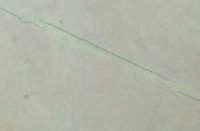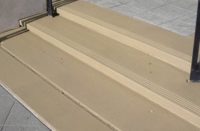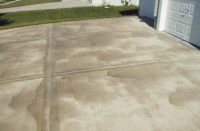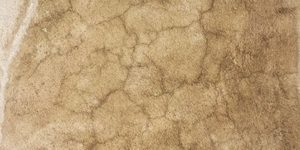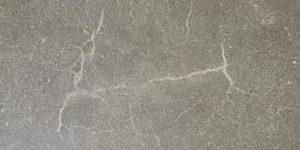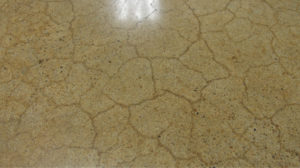 There are two basic approaches to incorporating cracks into the design of a cementitious floor: highlighting them and hiding them.
There are two basic approaches to incorporating cracks into the design of a cementitious floor: highlighting them and hiding them.
One ever-popular way to hide cracks is to conceal them as grout lines in a flagstone pattern.
Tom Ralston of Tom Ralston Concrete in Santa Cruz, Calif., used this camouflage concept while resurfacing a residential driveway with a few long, deep cracks running through it. Ralston filled the cracks with a flexible caulking, which he dusted with sand for a grout-like look. Then he applied a 3⁄8″ cementitious overlay along one side of the filled cracks, forming 2- to 3-foot wide bands of topping along the cracks. With a stick, he carved through the wet topping down to the slab, creating additional grout lines and forming faux flagstones. He colored the flagstones with earth-toned dry-shake colors, then sealed them. He covered the rest of the driveway with an integrally colored topping, feathering it up against the flagstones. Any slop that got onto the flagstone washed right off, thanks to the sealer.
After a day he washed the entire driveway with muriatic acid, which brought up the sand grit for a more natural feel. “It looked awesome,” Ralston says.
The finished driveway was featured in Sunset Magazine.
 Victor Pachade of Colormaker Floors in Vancouver, Canada, tells of a faux flagstone pattern that Colormaker created while staining a cracked floor at a cancer care center in Yakima, Wash. The cracks were filled with anchoring cement, then sprayed with muriatic acid. Muriatic acid was also sprayed in a few other meandering lines across the floor to delineate a pattern of enormous flagstones. Then the entire floor was stained.
Victor Pachade of Colormaker Floors in Vancouver, Canada, tells of a faux flagstone pattern that Colormaker created while staining a cracked floor at a cancer care center in Yakima, Wash. The cracks were filled with anchoring cement, then sprayed with muriatic acid. Muriatic acid was also sprayed in a few other meandering lines across the floor to delineate a pattern of enormous flagstones. Then the entire floor was stained.
“The areas that were sprayed with the muriatic acid did not react to the acid stain, so there wasn’t any acid stain color there,” Pachade says. “That formed a border or a grout line for the flagstone.”
Sometimes contractors opt to emphasize good-looking cracks.
“A crack is like a living thing,” says Mark Donaldson, owner of Skookum Floors in Seattle. “It occurs and it kind of does its own thing and moves in its own direction. Most of the time it could be interpreted as something it’s not.”
Donaldson sometimes transforms cracks into crawling vines by chasing them and filling them with colored grout. To complete the effect he might put flowery splashes of color at the ends of the cracks.
For interesting color effects, Donaldson likes to fill a crack with acid stain and then blast the crack with compressed air. “The color kind of explodes from the crack,” he says.
One idea Donaldson would like to try is to embed rope lighting (that flexible plastic tube lighting) into some cracks with a clear epoxy. “Your cracks would have a glow in them,” he says. “I’ve never done it before, but I always thought that would be cool.”
 Of course, another way to go is to simply let cracks be cracks. Cracks can add character to a floor, especially a stained floor, notes Ron Cottingham, decorative concrete program manager for Dayton Superior.
Of course, another way to go is to simply let cracks be cracks. Cracks can add character to a floor, especially a stained floor, notes Ron Cottingham, decorative concrete program manager for Dayton Superior.
“The idea with stains is to make a floor look timeworn and patined,” he says. “When stain gets down in a crack, it darkens along the edges and makes the crack more visual, so it become part of your design.”
And why not show off a genuine concrete crack? After all, some clients pay good money for fake ones, Cottingham points out. “In the stamping business, we manufacture stone or slate textured skins that have cracks in them, where we make the new concrete look like it has cracks!” he says.
